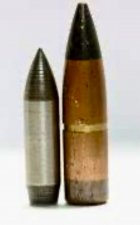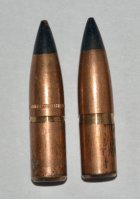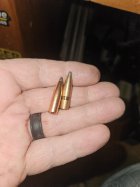Coyotefurharvester
Silver $$ Contributor
A pressure band, are these bullets pre lead free bullets. Or did military steel core need a pressure relief band? Did Barnes use this early Nosler technology in their bullet design?
Not say later ST post dated Partitions, l meant the later improved jacketed soft points, such as Rem CL’s (which was Nosler had used on the moose that failed to inspire him and his partition). Don’t know why l said later ST’s, sorry. Alot of early thin jacketed cup and core bullets were complete failures close range, but then improved two part core, softer front harder rear H mantle German AWS similar to Noslers Partition.The Winchester Silver Tip actually predates the Nosler Partition by about 8 years (1939/1940). It was popular in most of the calibers it was loaded for, although a bit more research is required to gather a list from that era.
It was indeed an improvement over the common cup/core bullets of the day; however, with the growing use of scopes and newer cartridges to extend range to Hunters everywhere, the appeal of the Nosler to expand/penetrate at all practical ranges made it a winner.
I’m not bashing the ST, nor am I advocating the Partition as the ultimate choice, as I have taken Whitetails (thus far) with both.
As you stated, shot placement was my primary concern, and I know my max range limitations.
I have some partitions that look just like those. They the only partitions I have in my supply some 7mm that look like those. Got them from a friend via an estate sale. I was about to buy some new ones, but I'm trying the accubonds instead.I’m looking for correct identification of some bullets I believe are partitions but I’m not sure. I recently sold a few boxes of .270 caliber bullets, part of which was a couple partial boxes of partitions, at least they were in a partition box. When the buyer recieved them he wanted to send them back because the bullets didn’t look like partitions to him. I told him to send them back and I refunded him. To be clear the purpose of this post is not to sling mud or be critical in any way, the purpose is to get opinions or a positive ID on these bullets. I understand where he was coming from.
These bullets came from my Dad’s inventory, he passed in July and I’ll never use them. One of the boxes had a price tag of 5.55 for a box of 50 which gives you an idea how old those are. I looked up the history of partitions which was kind of interesting in itself and I added a link to that article below. I also highlighted one paragraph which kind of sounds like these bullets where a groove was machined in the middle of the bullet where the inner copper divider is.
I could sand one of the bullets in half to see what the inside looks like but I’m hoping to ID them without that.
I’m hoping some of you guys who are familiar with the early partitions will chime In. I’m gonna relist these and I want to make sure I’m comfortable claiming they are partitions. Any help is appreciated.
https://www.americanrifleman.org/content/70-years-of-the-nosler-partition/
That's not a pressure band, those are the original Partitions made on a screw machine which is a small automatic lathe used for high production rates of small (back then) parts way before the CNC stuff became affordable. The solid copper rod was bored from each end leaving a wall (partition) in the center and the cavities were filled with lead. Those are not steel core.A pressure band, are these bullets pre lead free bullets. Or did military steel core need a pressure relief band? Did Barnes use this early Nosler technology in their bullet design?
I believe the primary goal of machining the waist of the M2 AP bullets was simply to allow crimping the bullet without potential deformation of the jacket, or core.A pressure band, are these bullets pre lead free bullets. Or did military steel core need a pressure relief band? Did Barnes use this early Nosler technology in their bullet design?


Oh Yes, the Core-Lokt Remingtons with their bonded jacket/core was a huge leap forward, and Speer followed suit with their mechanically bonded “Hot Core” bullets.Not say later ST post dated Partitions, l meant the later improved jacketed soft points, such as Rem CL’s (which was Nosler had used on the moose that failed to inspire him and his partition). Don’t know why l said later ST’s, sorry. Alot of early thin jacketed cup and core bullets were complete failures close range, but then improved two part core, softer front harder rear H mantle German AWS similar to Noslers Partition.
Gotcha.The American rifleman article, said there was a pressure issue with the bullets when the lead core was changed from molten to solid lead insertion. The hard copper jacket also played apart in the pressure issue. The band solved the pressure issue.
Old versus newI’m looking for correct identification of some bullets I believe are partitions but I’m not sure. I recently sold a few boxes of .270 caliber bullets, part of which was a couple partial boxes of partitions, at least they were in a partition box. When the buyer recieved them he wanted to send them back because the bullets didn’t look like partitions to him. I told him to send them back and I refunded him. To be clear the purpose of this post is not to sling mud or be critical in any way, the purpose is to get opinions or a positive ID on these bullets. I understand where he was coming from.
These bullets came from my Dad’s inventory, he passed in July and I’ll never use them. One of the boxes had a price tag of 5.55 for a box of 50 which gives you an idea how old those are. I looked up the history of partitions which was kind of interesting in itself and I added a link to that article below. I also highlighted one paragraph which kind of sounds like these bullets where a groove was machined in the middle of the bullet where the inner copper divider is.
I could sand one of the bullets in half to see what the inside looks like but I’m hoping to ID them without that.
I’m hoping some of you guys who are familiar with the early partitions will chime In. I’m gonna relist these and I want to make sure I’m comfortable claiming they are partitions. Any help is appreciated.
https://www.americanrifleman.org/content/70-years-of-the-nosler-partition/


Those are pretty cool, kind of wish I didn’t sell the ones I had. Cool piece of history.Old versus new
I scored on 200 7mm 140gr partitions.
I grabbed roughly 10 of each and weighed them.
Older 139.5-139.6 gr pretty consistent
New design 139.4 to
Check out the difference in jacket material, also it feels rough to the touch, not smooth and polished as the new model.
140.2grView attachment 1639201View attachment 1639202
The thing I like the best about this here torpedo bullet is, You can load it from either direction!Brenneke makes some great bullets as well; this one similar to the Speer Grand Slam with two cores of differing hardness to promote expansion and penetration.
View attachment 1598382
View attachment 1598383
Not sure the BC would be as efficient, but likely penetrate well.The thing I like the best about this here torpedo bullet is, You can load it from either direction!
That's what I'd use today if chasing game. Ballistic tips were my go to bullet for mule deer and smaller, PTs for everything bigger. Unlike some, I never had a failure with the BT.From reading testimonials, the Accubond is now a better bullet In terminal performance.

